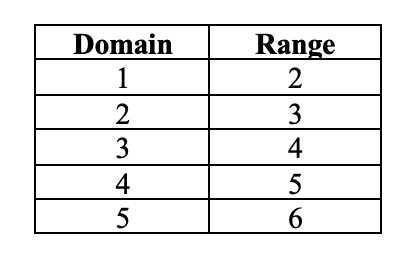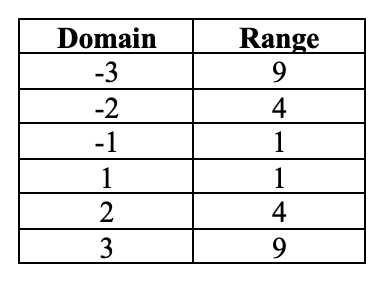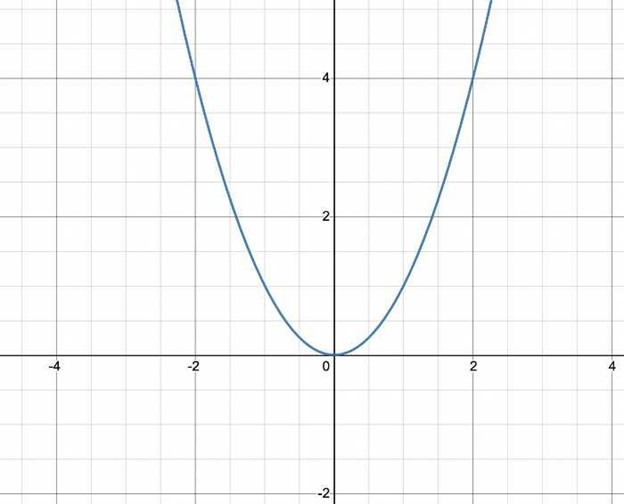One to One Functions - Graph, Examples | Horizontal Line Test
What is a One to One Function?
A one-to-one function is a mathematical function where each input corresponds to a single output. That is to say, for every x, there is just one y and vice versa. This means that the graph of a one-to-one function will never intersect.
The input value in a one-to-one function is the domain of the function, and the output value is the range of the function.
Let's study the images below:

For f(x), any value in the left circle corresponds to a unique value in the right circle. Similarly, each value on the right side correlates to a unique value on the left side. In mathematical words, this implies every domain has a unique range, and every range holds a unique domain. Therefore, this is a representation of a one-to-one function.
Here are some more examples of one-to-one functions:
-
f(x) = x + 1
-
f(x) = 2x
Now let's examine the second picture, which displays the values for g(x).
Be aware of the fact that the inputs in the left circle (domain) do not hold unique outputs in the right circle (range). For example, the inputs -2 and 2 have identical output, i.e., 4. In the same manner, the inputs -4 and 4 have the same output, i.e., 16. We can see that there are identical Y values for many X values. Therefore, this is not a one-to-one function.
Here are some other representations of non one-to-one functions:
-
f(x) = x^2
-
f(x)=(x+2)^2
What are the properties of One to One Functions?
One-to-one functions have the following qualities:
-
The function owns an inverse.
-
The graph of the function is a line that does not intersect itself.
-
They pass the horizontal line test.
-
The graph of a function and its inverse are identical concerning the line y = x.
How to Graph a One to One Function
To graph a one-to-one function, you will have to determine the domain and range for the function. Let's look at a straight-forward representation of a function f(x) = x + 1.

Immediately after you possess the domain and the range for the function, you have to plot the domain values on the X-axis and range values on the Y-axis.
How can you determine whether or not a Function is One to One?
To prove if a function is one-to-one, we can apply the horizontal line test. As soon as you plot the graph of a function, trace horizontal lines over the graph. If a horizontal line passes through the graph of the function at more than one spot, then the function is not one-to-one.
Due to the fact that the graph of every linear function is a straight line, and a horizontal line will not intersect the graph at more than one point, we can also deduct all linear functions are one-to-one functions. Keep in mind that we do not leverage the vertical line test for one-to-one functions.
Let's examine the graph for f(x) = x + 1. Once you graph the values for the x-coordinates and y-coordinates, you ought to review whether a horizontal line intersects the graph at more than one point. In this instance, the graph does not intersect any horizontal line more than once. This means that the function is a one-to-one function.

On the contrary, if the function is not a one-to-one function, it will intersect the same horizontal line more than one time. Let's examine the graph for the f(y) = y^2. Here are the domain and the range values for the function:

Here is the graph for the function:

In this instance, the graph meets multiple horizontal lines. Case in point, for both domains -1 and 1, the range is 1. Similarly, for either -2 and 2, the range is 4. This implies that f(x) = x^2 is not a one-to-one function.
What is the inverse of a One-to-One Function?
Considering the fact that a one-to-one function has a single input value for each output value, the inverse of a one-to-one function also happens to be a one-to-one function. The opposite of the function basically reverses the function.
For example, in the example of f(x) = x + 1, we add 1 to each value of x for the purpose of getting the output, in other words, y. The opposite of this function will deduct 1 from each value of y.
The inverse of the function is f−1.
What are the properties of the inverse of a One to One Function?
The qualities of an inverse one-to-one function are identical to all other one-to-one functions. This implies that the reverse of a one-to-one function will hold one domain for each range and pass the horizontal line test.
How do you determine the inverse of a One-to-One Function?
Figuring out the inverse of a function is simple. You just have to switch the x and y values. For instance, the inverse of the function f(x) = x + 5 is f-1(x) = x - 5.

Considering what we reviewed previously, the inverse of a one-to-one function reverses the function. Because the original output value showed us we needed to add 5 to each input value, the new output value will require us to subtract 5 from each input value.
One to One Function Practice Examples
Examine the following functions:
-
f(x) = x + 1
-
f(x) = 2x
-
f(x) = x2
-
f(x) = 3x - 2
-
f(x) = |x|
-
g(x) = 2x + 1
-
h(x) = x/2 - 1
-
j(x) = √x
-
k(x) = (x + 2)/(x - 2)
-
l(x) = 3√x
-
m(x) = 5 - x
For any of these functions:
1. Figure out whether or not the function is one-to-one.
2. Plot the function and its inverse.
3. Figure out the inverse of the function numerically.
4. Indicate the domain and range of both the function and its inverse.
5. Employ the inverse to solve for x in each formula.
Grade Potential Can Help You Learn You Functions
If you are struggling using one-to-one functions or similar concepts, Grade Potential can put you in contact with a private teacher who can assist you. Our Berekley math tutors are experienced educators who help students just like you improve their mastery of these subjects.
With Grade Potential, you can learn at your own pace from the comfort of your own home. Schedule a meeting with Grade Potential today by calling (925) 481-5394 to find out more about our educational services. One of our team members will contact you to better inquire about your needs to provide you with the best teacher for you!




